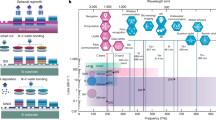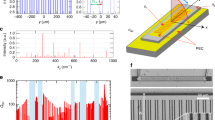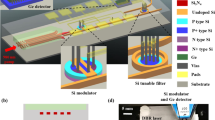Abstract
Fully exploiting the silicon photonics platform for large-volume, cost-sensitive applications requires a fundamentally new approach to directly integrate high-performance laser sources using wafer-scale fabrication methods. Direct-bandgap III–V semiconductors allow efficient light generation, but the large mismatch in lattice constant, thermal expansion and crystal polarity makes their epitaxial growth directly on silicon extremely complex. Using a selective-area growth technique in confined regions, we surpass this fundamental limit and demonstrate an optically pumped InP-based distributed feedback laser array monolithically grown on (001)-silicon operating at room temperature and suitable for wavelength-division-multiplexing applications. The novel epitaxial technology suppresses threading dislocations and anti-phase boundaries to a less than 20-nm-thick layer, which does not affect device performance. Using an in-plane laser cavity defined using standard top-down lithographic patterning together with a high yield and high uniformity provides scalability and a straightforward path towards cost-effective co-integration with silicon photonic and electronic circuits.
This is a preview of subscription content, access via your institution
Access options
Subscribe to this journal
Receive 12 print issues and online access
$209.00 per year
only $17.42 per issue
Buy this article
- Purchase on Springer Link
- Instant access to full article PDF
Prices may be subject to local taxes which are calculated during checkout




Similar content being viewed by others
References
Liu, A. et al. A high-speed silicon optical modulator based on a metal–oxide–semiconductor capacitor. Nature 427, 615–618 (2004).
Xu, Q., Schmidt, B., Pradhan, S. & Lipson, M. Micrometre-scale silicon electro-optic modulator. Nature 435, 325–327 (2005).
Assefa, S., Xia, F. & Vlasov, Y. A. Reinventing germanium avalanche photodetector for nanophotonic on-chip optical interconnects. Nature 464, 80–84 (2010).
Michel, J., Liu, J. F. & Kimerling, L. C. High-performance Ge-on-Si photodetectors. Nature Photon. 4, 527–534 (2010).
Soref, R. The past, present, and future of silicon photonics. IEEE J. Sel. Top. Quantum Electron. 12, 1678–1687 (2006).
Miller, D. A. B. Device requirements for optical interconnects to silicon chips. Proc. IEEE 97, 1166–1185 (2009).
Gunn, C. CMOS photonics for high-speed interconnects. IEEE Micro. 26, 58–66 (2006).
Ohashi, K. et al. On-chip optical interconnect. Proc. IEEE 97, 1186–1198 (2009).
Fang, A. W. et al. Electrically pumped hybrid AlGaInAs–silicon evanescent laser. Opt. Express 14, 9203–9210 (2006).
Van Campenhout, J. et al. Electrically pumped InP-based microdisk lasers integrated with a nanophotonic silicon-on-insulator waveguide circuit. Opt. Express 15, 6744–6749 (2007).
Liu, L. et al. An ultra-small, low-power, all-optical flip-flop memory on a silicon chip. Nature Photon. 4, 182–187 (2010).
Rong, H. et al. A continuous-wave Raman silicon laser. Nature 433, 725–728 (2005).
Liu, J. F., Sun, X. C., Camacho-Aguilera, R., Kimerling, L. C. & Michel, J. Ge-on-Si laser operating at room temperature. Opt. Lett. 35, 679–681 (2010).
Takahashi, Y. et al. A micrometre-scale Raman silicon laser with a microwatt threshold. Nature 498, 470–474 (2013).
Wirths, S. et al. Lasing in direct-bandgap GeSn alloy grown on Si. Nature Photon. 9, 88–92 (2015).
ITRS. International Technology Working Groups International Technology Roadmap for Semiconductors (2010); http://www.itrs.net/
Ayers, J. E. Heteroepitaxy of Semiconductors – Theory, Growth, and Characterization (CRC, 2007).
Hossain, N. et al. Reduced threshold current dilute nitride Ga(NAsP)/GaP quantum well lasers grown by MOVPE. Electron. Lett. 47, 931–933 (2011).
Reboul, J. R., Cerutti, L., Rodriguez, J. B., Grech, P. & Tournie, E. Continuous-wave operation above room temperature of GaSb-based laser diodes grown on Si. Appl. Phys. Lett. 99, 121113 (2011).
Chen, S. M. et al. 1.3 μm InAs/GaAs quantum-dot laser monolithically grown on Si substrates operating over 100 °C. Electron. Lett. 50, 1467–1468 (2014).
Wang, T., Liu, H., Lee, A., Pozzi, F. & Seeds, A. 1.3-μm InAs/GaAs quantum-dot lasers monolithically grown on Si substrates. Opt. Express 19, 11381–11386 (2011).
Chen, R. et al. Nanolasers grown on silicon. Nature Photon. 5, 170–175 (2011).
Wang, Z. et al. Polytypic InP nanolaser monolithically integrated on (001) silicon. Nano. Lett. 13, 5063–5069 (2013).
del Alamo, J. A. Nanometre-scale electronics with III–V compound semiconductors. Nature 479, 317–323 (2011).
Guo, W. et al. Selective metal–organic chemical vapor deposition growth of high quality GaAs on Si(001). Appl. Phys. Lett. 105, 062101 (2014).
Merckling, C. et al. Selective-area metal organic vapor-phase epitaxy of III–V on Si: what about defect density? ECS Trans. 64, 513–521 (2014).
Merckling, C. et al. Heteroepitaxy of InP on Si(001) by selective-area metal organic vapor-phase epitaxy in sub-50 nm width trenches: the role of the nucleation layer and the recess engineering. J. Appl. Phys. 115, 023710 (2014).
Waldron, N. et al. InGaAs gate-all-around nanowire devices on 300mm Si substrates. IEEE Electron. Device Lett. 35, 1097–1099 (2014).
Paladugu, M. et al. Site selective integration of III–V materials on Si for nanoscale logic and photonic devices. Cryst. Growth Des. 12, 4696–4702 (2012).
Mitsuru, S., Hidefumi, M., Yoshio, I., Yoshihisa, S. & Masami, T. 1.5 µm-long-wavelength multiple quantum well laser on a Si substrate. Jpn J. Appl. Phys. 30, 3876 (1991).
Yang, J. & Bhattacharya, P. Integration of epitaxially-grown InGaAs/GaAs quantum dot lasers with hydrogenated amorphous silicon waveguides on silicon. Opt. Express 16, 5136–5140 (2008).
Liu, H. Y. et al. Long-wavelength InAs/GaAs quantum-dot laser diode monolithically grown on Ge substrate. Nature Photon. 5, 416–419 (2011).
Boroditsky, M. et al. Surface recombination measurements on III–V candidate materials for nanostructure light-emitting diodes. J. Appl. Phys. 87, 3497 (2000).
Cohen, D. & Carter, C. B. Structure of the (110) antiphase boundary in gallium phosphide. J. Microsc. 208, 84–99 (2002).
Narayanan, V., Mahajan, S., Bachmann, K. J., Woods, V. & Dietz, N. Antiphase boundaries in GaP layers grown on (001) Si by chemical beam epitaxy. Acta Mater. 50, 1275–1287 (2002).
Coldren, L. A., Corzine, S. W. & Mashanovitch, M. L. Diode Lasers and Photonic Integrated Circuits 2nd edn (Wiley, 2012).
Tatebayashi, J. et al. Room-temperature lasing in a single nanowire with quantum dots. Nature Photon. 9, 501–505 (2015).
Koch, T. L. & Bowers, J. E. Nature of wavelength chirping in directly modulated semiconductor lasers. Electron. Lett. 20, 1038–1040 (1984).
Casey, H. C. & Buehler, E. Evidence for low surface recombination velocity on n-type InP. Appl. Phys. Lett. 30, 247 (1977).
Duan, X., Huang, Y., Agarwal, R. & Lieber, C. M. Single-nanowire electrically driven lasers. Nature 421, 241–245 (2003).
Waldron, N. et al. An InGaAs/InP quantum well FinFET using the replacement fin process integrated in an RMG flow on 300 mm Si substrates. IEEE Symposium on VLSI Technology 2014: Digest of Technical Papers 1–2 (2014).
Acknowledgements
This work was supported by the European Commission through ERC project ULPPIC (Ultra Low Power Photonic IC) and imec's industry-affiliation programme on optical I/O. The authors thank R. Baets, G. Roelkens and N. Le Thomas for discussions.
Author information
Authors and Affiliations
Contributions
D.V.T. proposed and coordinated the overall project. J.V.C., Z.W. and P.A. suggested the idea of an in-plane laser on silicon. B.T. explored the theoretical design. Z.W. developed the process flow. C.M. and W.G. carried out the epitaxial growth. M.P. processed the silicon template. B.T. and Z.W. performed the photoluminescence characterizations. Z.W. and D.V.T. composed the manuscript.
Corresponding author
Ethics declarations
Competing interests
The authors declare no competing financial interests.
Supplementary information
Supplementary information
Supplementary information (PDF 935 kb)
Rights and permissions
About this article
Cite this article
Wang, Z., Tian, B., Pantouvaki, M. et al. Room-temperature InP distributed feedback laser array directly grown on silicon. Nature Photon 9, 837–842 (2015). https://doi.org/10.1038/nphoton.2015.199
Received:
Accepted:
Published:
Issue Date:
DOI: https://doi.org/10.1038/nphoton.2015.199
This article is cited by
-
Prospects and applications of on-chip lasers
eLight (2023)
-
Room-temperature continuous-wave topological Dirac-vortex microcavity lasers on silicon
Light: Science & Applications (2023)
-
Mid-infrared III–V semiconductor lasers epitaxially grown on Si substrates
Light: Science & Applications (2022)
-
Photoresponsivity, Electrical and Dielectric Properties of GaAs/P-Si Heterojunction-Based Photodiode
Silicon (2022)
-
Direct Bandgap Type-I Ge Quantum Dots/GeSnSi for SWIR and MWIR Lasers
Electronic Materials Letters (2022)



